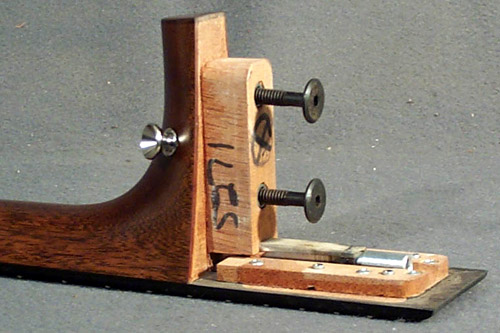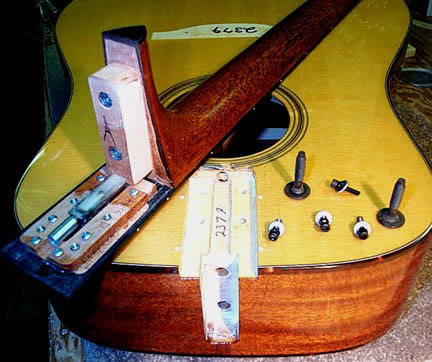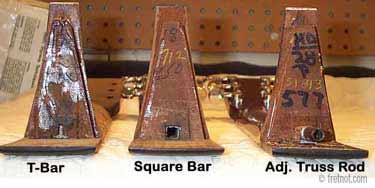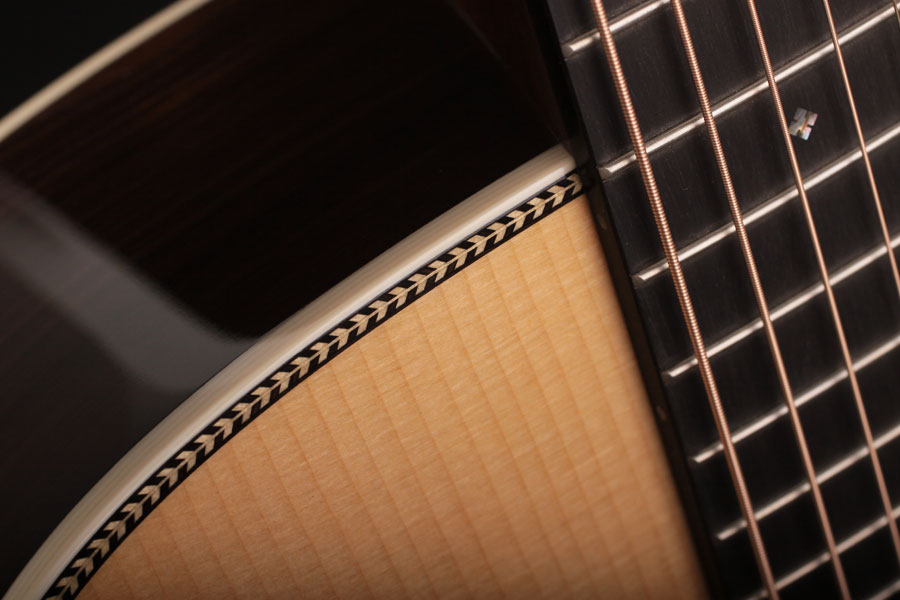Guitars, religion, evidence, and beliefs
 Beliefs about characteristics and generalizations of acoustic guitars, and their associated construction techniques and materials, seems to me to be a lot like religion. As an atheist this is weird for me to think about, but we (guitar players) make a lot of leaps of faith based on scant evidence (what we scientists call an "N of one"), what others have told us, and what makes "reasonable sense" to us as individuals. How much of what we believe, prefer, and hear in our instruments is based in tradition, expectations, superstition, illusory correlations, and what we read in books/magazines and on the internet?
Beliefs about characteristics and generalizations of acoustic guitars, and their associated construction techniques and materials, seems to me to be a lot like religion. As an atheist this is weird for me to think about, but we (guitar players) make a lot of leaps of faith based on scant evidence (what we scientists call an "N of one"), what others have told us, and what makes "reasonable sense" to us as individuals. How much of what we believe, prefer, and hear in our instruments is based in tradition, expectations, superstition, illusory correlations, and what we read in books/magazines and on the internet?
Another interesting parallel between acoustic guitar players and religion, although somewhat of a sidenote to this discussion, is that we are inherently conservative; it takes a long time to get us guitar players to change the standards of what is perceived as "normal" or preferable. For example, I'm really interested in seeing how the necessary future use of sustainable "alternatives" tonewoods is embraced by players/consumers. While I love the idea of walnut and cherry guitars that are made from timbers locally and responsibly harvested, given the choice, I'd still take my tried-and-true Honduran mahogany!
I really have great respect and envy for those few folks who have played hundreds and thousand of vintage and new guitars, and for those who build instruments (i.e., and do "experiments" to learn about acoustic properties of materials and construction techniques); those people with lots of data to base their beliefs on. Unfortunately, that's not me (yet?).
Keeping these reservations in mind, here are my guitar beliefs; much like religion, they are based on a small sample size, what people I respect think, and what "makes reasonable sense" given my basic knowledge of physics and lutherie. Some of these beliefs are probably totally irrational, and like religion, we could get into endless and unwinnable debates about all of these points:*
*However, unlike religion, the below points could all be tested experimentally,
and I'd happily change my mind in the face of good evidence.
- Lots of little things add up to a good sounding guitar. There are many "ingredients" that can be slightly changed, and these are the things that, in sum, create the unique tonal signatures of individual instruments and general characteristics of different acoustic guitar brands.
- I believe that hide glue positively impacts the sound of a guitar compared to titebond or other commonly used adhesives, which have more "flex" to them.
- I don't believe that, as a broad statement, lighter guitars sound better than heavier guitars (and I'm not talking about lightness of soundboard/bracing; that's another issue, and much less debatable). In terms if the thickness and stiffness of the sides/back of the instrument, I wonder if this impacts the projection of the sound outward versus feeling more vibrations as a player. I do, however, prefer the feeling of playing a light weight acoustic guitar, but that's probably more due to ergonomics.
 Bourgeois neck (from pantheonguitars.com)
Bourgeois neck (from pantheonguitars.com)

- Bolt-on vs. dovetailed necks: I believe that both can be excellent sounding, but that the type of neck joint probably does impact the tonal qualities of a guitar (although I can't say how). I like Collings (bolt-on) and I like Martin (dovetail). But bolt-on does add a bit a weight. I love, in principle, the design of bolt-on necks that don't glue the fingerboard to the top of the guitar (i.e., Taylor's NT neck and similar designs used by Bourgeois, my friend David Cavins, and like we did at the Vermont Instruments School of Lutherie) due to the relative ease of maintenance. I'm sure it colors the sound somehow, and it certainly does impact the overall weight of the instrument.
 Image source: fretnotguitarrepair.comWith the commercial success of Martin's "Authentic" series, which employs non-adjustable T-bar truss rods in many models (and non-adjustable ebony in others), there's been a renewed discussion in the relative merits of adjustable vs. non-adjustable truss rods. Like with neck joints, my guess is that there is a sonic difference, but this is one place I'd rather err on the side of modernity...I'll take adjustable over not if given the choice, especially if I'm buying a used guitar (like I tend to do).
Image source: fretnotguitarrepair.comWith the commercial success of Martin's "Authentic" series, which employs non-adjustable T-bar truss rods in many models (and non-adjustable ebony in others), there's been a renewed discussion in the relative merits of adjustable vs. non-adjustable truss rods. Like with neck joints, my guess is that there is a sonic difference, but this is one place I'd rather err on the side of modernity...I'll take adjustable over not if given the choice, especially if I'm buying a used guitar (like I tend to do).- I don't have enough personal experience with Brazilian rosewood to make statements about it's merits compared to Indian or other rosewoods. But I believe that the use of good Brazilian (i.e., quarter-sawn) is confounded with a lot of other variables that I do think are important (i.e., the use of hide glue, T-bar truss rods, age of the wood, and break-in time for vintage guitars). I'd love to spend some time with some guitar sporting various rosewoods that are otherwise as identical as possible.
- I do believe that herringbone purfling (or other similar decorative details around the top, like pearl inlay) could have a small impact on the sound, due to the wider channel being routed into the top right where it's connecting to the sides (maybe more flex = a bit more bass? just thinking theoretically, here).
 Herringbone Martin (image from folkwaysmusic.com...lots of nice guitars on their website!)
Herringbone Martin (image from folkwaysmusic.com...lots of nice guitars on their website!)
- I have heard a similar argument about sunburst tops: that the extra pigment that is applied to certain areas ever-so-slightly changes the mass of the top in those areas, which changes the sound. This seems far-fetched to me. In my opinion, if you do want to make the claim that sunbursts sound different/better (and I'm not a all convinced about this claim, although I love a good sunburst), what makes more sense is thinking about the stack of cosmetically "flawed" wood that could not be used if not for the shaded top...That there's lots of great sounding wood to choose from if you ignore cosmetics, and sunbursts allow luthiers to pick tops based on tonal properties only without having to balance the look of the top in their selection.
- I think there is probably significant overlap in the distribution of Sitka vs. Adirondack tops (i.e., normal curves that overlap), but that there are some characteristic differences between them on average. But that "different" does not globally mean "better."
- I suspect that the labels of "European," "German," "Italian" etc. spruce that are used are not particularly useful, because they refer to where the wood came from, not a particular species. That's not to say they don't sound and look different that your typical Sitka top, but that it's not so clear, across makers, what the consistent tonal properties of these woods are.
- In theory I like idea of Madagascar rosewood as an alternative to Brazilian, but I'm uncomfortable with it due to the socio-political and environmental concerns associated with its harvest (more about this topic here and here). For my own piece of mind, along with all the reasons to buy vintage, if I wanted a rosewood guitar, I'd pony up the dough and get a '50s-era D-28 or '45-55 000-21 or 000-28, and not one of the re-issues or custom models that many manufactures have rolled out recently.
- That wood, as a material that is/was alive, continues to change both due to aging and playing (i.e., the "opening up" that players described is a function of at least two processes that impact the structure of the wood itself).
- Related to the above point: I believe that part, but not all, of the "opening up" process is psychological-- that we become more familiar with the sound of a guitar over time, and that is perceived as more pleasing. Yes, remember that I'm a social psychologist, and that we call this the "mere exposure effect."
- One of my biggest "turn-offs" are the pixelated pickguards that Martin used (still uses?) on some of their guitars, like my 2002 D-18GE. I've since replaced mine with a "tor-tis" Dalmatian pickguard, which is admittedly a non-traditional choice for an -18-style guitar.
![]() Ick! (from http://www.acousticguitarforum.com/forums/showthread.php?t=266220)
Ick! (from http://www.acousticguitarforum.com/forums/showthread.php?t=266220)

 Saturday, January 26, 2013
Saturday, January 26, 2013